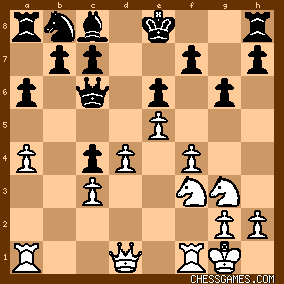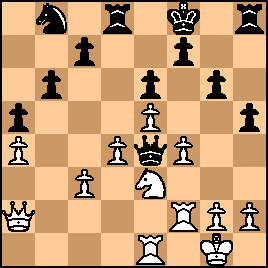Jul-30-05
 | | Honza Cervenka: <chessgames.com> This game was played by S. Loewenthal according to Tarrasch's Dreihundert Schachpartien. By the way, Johann Loewenthal died in 1876. |
|
Jan-14-20
 | | claurence57: More moves have been played according to Tarrasch himself in "300 chessgames" and Fred Reinfield in "Tarrasch's best games of chess" : 40 Rf6-f1 Qg5 41. Qe2 Rd5 42. Qe4 Nd3 43. e7 NxRe1 44. e8=Q 1-0. |
|
| Jun-10-23 | | Gaito: It is not clear whether Salomon Löwenthal (1843-1921) had any family relation with the famous Hungarian master Johann Jacob Löwenthal (1810-1876), one of the few masters who played both Morphy and Steinitz. |
|
| Jun-10-23 | | Gaito: 
click for larger viewBLACK TO MOVE
Notice that Black's queen has moved already 5 times out of the first 14 moves. In this position Black played 15...g6, a move that was widely criticized, as it does not contribute to Black's development, and weakens the dark squares, which is dangerous since Black already parted with his dark-square bishop. Some modern engines (like Stockfish), however, suggest that Black can safely play 15...g6, but let us not forget that engines defend way better than human players do! Reinfeld commented (quote) "He is anxious to keep the knight out of h5, even at the cost of weakening the black squares". (end of quote). Therefore, a natural question is: could Black have castled safely in this position, or maybe 15...g6 was a necessary defensive move? The following is a possible variation after 15...O-O: 16.Nh5 Qe8 17.Ng5 Nd7 (see diagram below):

click for larger view18.Nxh7! Kxh7 19.Qg4! g6 20.Qh4 and wins.
Thus we can conclude that Black probably made the right decision by playing 15...g6, but his position was already very difficult. |
|
| Jun-10-23 | | Gaito: 
click for larger viewWHITE TO MOVE
16.Qb1!? was an interesting move, played perhaps with a view to preventing an eventual ....b5 by Black, but a modern master would probably have played the more economical 16.a5! instead, with the same effect, and also grabbing more space on the queen's wing. |
|
| Jun-10-23 | | Gaito: 
click for larger viewBLACK TO PLAY
The diagrammed position was a critical moment of the game: Black's pieces are scattered and lack coordination, but he is far from being lost. Those are the good news; the bad news is that he is faced with a difficult defensive task. As mentioned in another comment below, human players (even masters) usually find it very diffcult to defend well in an awkward position. There are of course, many exceptions, like Korchnoi or Dr. Lasker, or Petrosian or Magnus, etc. Those guys would probably have been able to hold on and draw with Black (maybe even win!). But for the rest of mortals it is usually an extremely difficult undertaking to find the correct defensive moves in an awkward position like this one. Engines, of course, can defend extremely well, even bettter than Korchnoi or those guys. Komodo 13, for example, evaluates this position as "roughly equal", but of course, Komodo and its fellow silicon buddies are capable of finding astounding defensive resources that almost no human being could ever spot. How should Black defend in this position? Solomon Löwenthal played 30...Kg8? which turned out to be a losing move. The engines suggest that Black can probably hold his own with moves like 30...Qc6, 30...Ke8, or even the mysterious move 30...Rg8!? (recommended by Komodo 13). Naturally enough, the engines reach that conclusion after evaluating hundreds of millions of possible variations, but that is out of the question for a human player. |
|
| Jun-12-23 | | Gaito: Tarrasch was 20 years old when he played this game. It already bears his hallmark, which was a very logical and clear judgement, and a crystal clear understanding of the position. In contrast with the romantic masters of the past, like Adolf Anderssen, Tarrasch assimilated the teachings and priniciples of Wilhelm Steinitz, and showed them to advantage in his games. Steinitz and Tarrasch were the founders of modern positional chess; then Rubinstein, Lasker and Capablanca further developed that approach to the game of chess. Nowadays every master is familiar with it. |
|
|
|
|





































